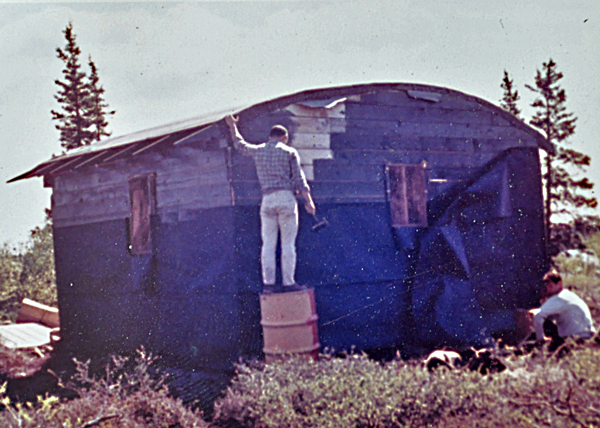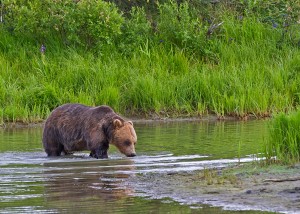
It was June, 1962, and I was in Anchorage, living temporarily at Terry D’s, waiting for July. Then I would fly to Dillingham to begin a temporary summer life as a salmon counter for the Alaska Department of Fish and Game.
ADFG has the responsibility of assuring sufficient migration to the spawning areas to produce a new generation of salmon.
Find more stories like this at Growing Up Anchorage
Experimentation has demonstrated that a ten-minute count from each bank of a river, multiplied by six, gives a reasonably accurate estimate for that hour. In the 1960’s, three-man crews of college boys were the sole source of accurate salmon data. These guys were usually biology majors, and during two summers I was hired because of my prior experience as a set-netter.
The location for each three-man crew was prepared at a place where the river was shallow. Requirements were: a cabin; two-way radio; boat and motor; and a 15-foot portable tower on each bank of the river. A generator was also provided to recharge car batteries for the radio and for car headlights needed for counting in the dark. A charter plane flew the three crew members, their gear and groceries to their new home for the summer.

Data collection begins when a young man docks the motorboat and climbs to the top of a tower. During daylight hours, he wears Polaroid sunglasses to minimize reflection from the water’s surface. He starts a ten-minute egg timer and holds two mechanical counters in each hand. He watches the light-colored wire mesh panel anchored on the river bottom in front of the tower. The wise salmon swim near the bank, where the river current is gentler, and the viewing angle from the tower is just about perfect. Our guy can distinguish the four main species by their silhouette against the mesh panel – coho/silver, red/sockeye, chinook/king and chum/dog – and he clicks the appropriate hand-held counter for each fish he sees. After ten minutes, the timer bell rings, and he records the four counts. He jumps in the motorboat to cross to the opposite bank and repeat the process.
The counting proceeds by eight-hour shifts around the clock, and nearly as many salmon are registered at night as during the day. During the long summer days, artificial light is needed only between 10 PM and 3 AM. For these counts in darkness, a car headlight mounted on the tower shines down, illuminating the mesh panel. Occasionally salmon are spooked by the light and hesitate before darting through the unaccustomed band of brilliance or try to avoid it by swimming nearer the center of the river. The experienced data collector is not fazed by these shenanigans; he clicks his counters accurately. 26,214 was our highest daily count recorded in my diary for 1962; I assume these were reds.
For three young guys bored with each other’s biographies and the social isolation, the day’s highlight is usually the radio report at 6 PM. The ADFG office in Dillingham calls each counting station by name and requests the daily totals for the four distinct species. This is also the opportunity to report any problems or order groceries. The various teams track each other’s totals, with each team hoping their river will be the leader in salmon numbers as a matter of personal honor.
I was sent out to the Nuyakuk River, a tributary of the much larger Nushagak, which flows into Bristol Bay at Dillingham. Our bush pilot was a real pro. Conserving fuel, he never took his Cessna 180 above 100 feet. His familiarity with our prospective location indicated that this was not his first trip.
He first buzzed the cabin to show us our new home and then landed expertly in a bend of the river a short distance upstream, where no trees crowded the water. Banking into the curve, he touched down first on the inside float, kicking the rudder to compensate for the unequal drag. He then cut the throttle so that the other float made contact with the water. What an impressive demonstration of flying ability! We drifted downstream to our cabin location and unloaded our gear onto the riverbank. Waving goodbye, our pilot headed his Cessna back upstream for takeoff from his favored curving stretch of river.
One evening in August, as I was counting on the east bank, I heard splashing in the shallows on the opposite side of the river. Scarcely able to contain my curiosity, I resolutely kept my eyes focused on the water right in front of my tower. When the timer bell sounded, I anxiously looked up to identify the cause of the splashing. A huge brown bear was plodding through the water near the opposite bank, heading upstream for a salmon feast in the shallow rapids. I remained motionless on top of my tower, hoping not to attract his attention and trying to remember what I had heard about brownies’ climbing ability. If he came up the tower, I hoped to repel him by swatting his nose with my clipboard. I waited up there for quite a long while, until the sounds of his splashing walk had receded in the distance. We saw him and his tracks several more times over the next few days.
Our location was a couple of miles upstream from Koliganek, a Yup’ik village of about 100 inhabitants. During the salmon season, nearly all the residents were aboard their driftnet boats on Bristol Bay. Two elderly brothers with Russian Orthodox names, Vasiliy and Nicolai, remained behind to take care of the village sled dogs. We looked forward to their occasional visits to our cabin as a departure from our daily routine.
Nicolai visited more often than Vasiliy, traveling the river in a small canvas kayak. Avoiding the stronger current, Nicolai kept to the shallows, using a pair of four-foot sticks to pole his way forward, and he made faster progress than a paddled canoe would have.
Nicolai especially enjoyed our favorite snack of pilot bread (like a large saltine cracker) with peanut butter and strawberry jam. Nicolai’s English language skill was limited, so after two or three of these culinary delights, he would signal his satisfaction by moving both hands in a vertical arc in front of his stomach and saying, “Too high!”
Late in the season, our generator failed. We depended on this generator to recharge the batteries for the radio and the car headlights. Our boss in Dillingham promised to fly out a new generator in a few days. Though unaware of the goodwill created by our hospitality to Vasiliy and Nicolai, the boss advised us to try to recharge the batteries in Koliganek.
Suspending the counting activity for a few hours, we loaded our three batteries in the boat and headed downstream. Following the end of the fishing season in Bristol Bay, Koliganek residents had returned upriver on their boats with the fruits of their summer work. Now the village was filled with people wearing new clothes and new boots. They had brought barrels of gas for their chainsaws and snow machines, winter supplies, Polaroid cameras and other trophies.
We were casually invited into the chief’s house for coffee. The large living room was furnished with four couches and two beds, providing seating for twenty people at a time. This was also the polling place for the first-ever primary election in Koliganek, held that day, so there was much activity. We met our friends Vasiliy and Nicolai again, along with a steady stream of residents curious about the college boys. We were shown many Polaroid pictures of fishing on Bristol Bay and the long trip to Koliganek, via the Nushagak and Nuyakuk Rivers.
Later the chief indicated that it was time to get down to business, so we carried our batteries to his boat, tied up at the bank near the village. The deck was crowded with children eager to observe and participate in this unprecedented event. The chief started the engine, and then opened the hatch of the engine compartment, intending to switch the battery cables to one of our batteries. Hoping to clear enough space so he could kneel beside the opening, the chief said loudly, “You kids get back. It’s going to explode!” Shocked by this warning, the kids each took two or three steps backwards. Cued by the chief’s laughter, they all giggled and surged forward again.
Eventually two of the batteries had an adequate temporary charge, and we thought we could manage by switching them between the headlights and the radio. I had enjoyed every moment of my opportunity to experience village life: the chief’s ongoing open house, the affection of the adults towards all the kids, everyone’s happiness following a successful salmon season. In the evening twilight we reluctantly loaded our boat for the trip upriver to our camp.
Eventually, of course, the salmon run ended, and the summer crews were rotated back to Dillingham or King Salmon. There we might be temporarily assigned to local ADFG maintenance jobs such as painting; in any case, we soon got our summer paychecks and were discharged. Looking forward to our return to civilization, we bought our plane tickets and left our wilderness experience behind.
My camera at the time was a twin-lens reflex, too bulky to hang from my neck during the acrobatics required of an ADFG salmon counter. My diary mentions some photo expeditions by boat or on foot, but where are those pictures today?
Jean’s family moved to Anchorage in 1957. Jean attended Anchorage High School, graduating with the Class of 1961, the last year for the one-and-only high school in Anchorage.
He held summer jobs in the bush during college. At the University of Oregon, he met Sue from Honolulu; they were married in 1964. They took their son and daughter to Germany for a decade while Jean taught English at a German school. The kids still speak German like natives.
Jean’s later experiences in the U.S. included being a German teacher, Harley biker, programmer-analyst and horse trainer. He is retired now on a ranchette near San Antonio, where he and his wife enjoy the grandkids, horses, dogs, cats, chickens and the wildlife. Jean inherited his Dad’s 5-string banjo and plays a little bluegrass.




